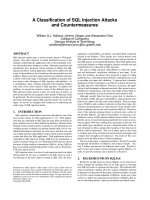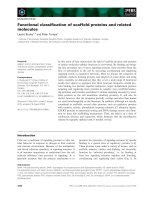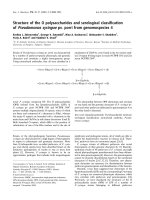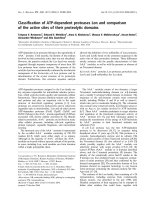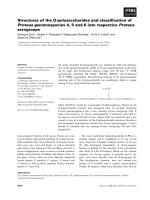SCOP: A Structural Classification of Proteins Database for the Investigation of Sequences and Structures ppt
Bạn đang xem bản rút gọn của tài liệu. Xem và tải ngay bản đầy đủ của tài liệu tại đây (3.3 MB, 5 trang )
JMB—MS 422 Cust. Ref. No. CAM 502/94
[SGML]
J. Mol. Biol.
(1995) 247, 536–540
COMMUNICATION
SCOP: A Structural Classification of Proteins Database
for the Investigation of Sequences and Structures
Alexey G. Murzin, Steven E. Brenner, Tim Hubbard and Cyrus Chothia*
MRC Laboratory of Molecular To facilitate understanding of, and access to, the information available for
protein structures, we have constructed the Structural Classification ofBiology and Cambridge
Centre for Protein Proteins (scop) database. This database provides a detailed and com-
prehensive description of the structural and evolutionary relationships ofEngineering, Hills Road
Cambridge CB2 2QH the proteins of known structure. It also provides for each entry links to
co-ordinates, images of the structure, interactive viewers, sequence data andEngland
literature references.Two search facilities are available. The homology search
permits users to enter a sequence and obtain a list of any structures to which
it has significant levels of sequence similarity. The key word search finds, for
a word entered by the user, matches from both the text of the scop database
and the headers of Brookhaven Protein Databank structure files. The
database is freely accessible on World Wide Web (WWW) with an entry point
to URL />scop: an old English poet or minstrel (Oxford English Dictionary);
ckon: pile, accumulation (Russian Dictionary).
Keywords: protein families; superfamilies; folds; evolutionary
relationships
*Corresponding author
Nearly all proteins have structural similarities
with other proteins and, in many cases, share a
common evolutionary origin. The knowledge of
these relationships makes important contributions to
molecular biology and to other related areas of
science. It is central to our understanding of the
structure and evolution of proteins. It will play an
important role in the interpretation of the sequences
produced by the genome projects and, therefore, in
understanding the evolution of development.
The recent exponential growth in the number of
proteins whose structures have been determined by
X-ray crystallography and NMR spectroscopy
means that there is now a large and rapidly growing
corpus of information available. At present (January,
1995) the Brookhaven Protein Databank (PDB,
(Abola et al., 1987)) contains 3091 entries and the
number is increasing by about 100 a month. To
facilitate the understanding of, and access to, this
information, we have constructed the Structural
Classification of Proteins (scop) database. This
database provides a detailed and comprehensive
description of the structural and evolutionary
relationships of proteins whose three-dimensional
structures have been determined. It includes all
proteins in the current version of the PDB and
almost all proteins for which structures have been
published but whose co-ordinates are not available
from the PDB.
The classification of protein structures in the
database is based on evolutionary relationships and
on the principles that govern their three-dimensional
structure. Early work on protein structures showed
that there are striking regularities in the ways in
which secondary structures are assembled (Levitt
& Chothia, 1976; Chothia et al., 1977) and in the
topologies of the polypeptide chains (Richardson,
1976, 1977; Sternberg & Thornton, 1976). These
regularities arise from the intrinsic physical and
chemical properties of proteins (Chothia, 1984;
Finkelstein & Ptitsyn, 1987) and provide the basis for
the classification of protein folds (Levitt & Chothia,
1976; Richardson, 1981). This early work has been
taken further in more recent papers; see, for example,
Holm & Sander (1993), Orengo et al. (1993),
Overington et al. (1993) and Yee & Dill (1993). An
extensive bibliography of papers on the classification
and the determinants of protein folds is given inscop.
The method used to construct the protein
classification in scop is essentially the visual
inspection and comparison of structures though
various automatic tools are used to make the task
manageable and help provide generality. Given the
Abbreviations used: PDB, Protein Databank; scop,
Structural Classification of Proteins.
0022–2836/95/140536–05 $08.00/0 7 1995 Academic Press Limited
JMB—MS 422
Communication
537
Figure 1. In scop, the unit of classification is usually the
protein domain. Small proteins, and most of those of
medium size, have a single domain and are, therefore,
treated as a whole. The domains in large proteins are
usually classified individually. The protein entries in the
December 1994 of the Brookhaven Protein Databank (PDB)
contain 3179 domains. Many of these become forms of the
same protein whose differences are not significant in terms
of the classification used here; for example they have
different bound ligands or engineered mutations. To
distinguish between these and structures of the same
protein from different organisms, proteins listed within a
family are subclassified by species. Classification of the
3179 domains show that they come from 498 families that
can be clustered into 366 superfamilies and 279 different
folds. In addition to these, scop contains entries for 195
proteins that do not have atomic co-ordinates available
from the PDB at present but for which description of their
structures have been published.
identities but whose functions and structures are
very similar; for example, globins with sequence
identities of 15%.
SUPERFAMILY. Families, whose proteins have
low sequence identities but whose structures and, in
many cases, functional features suggest that a
common evolutionary origin is probable, are placed
together in superfamilies; for example, actin, the
ATPase domain of the heat-shock protein and
hexokinase (Flaherty et al., 1991).
COMMON FOLD. Superfamilies and families are
defined as having a common fold if their proteins
have same major secondary structures in same
arrangement with the same topological connections.
In scop we give for each fold short descriptions of its
main structural features. Different proteins with the
same fold usually have peripheral elements of
secondary structure and turn regions that differ in
size and conformation and, in the more divergent
cases, these differing regions may form half or more
of each structure. For proteins placed together in the
same fold category, the structural similarities
probably arise from the physics and chemistry of
proteins favouringcertain packingarrangements and
chain topologies (see above). There may, however,
be cases where a common evolutionary origin is
obscured by the extent of thedivergence in sequence,
structure and function. In these cases, it is possible
that the discovery of new structures, with folds
between those of the previously known structures,
will make clear their common evolutionary relation-
ship.
CLASS. For convenience of users, the different
folds have been grouped into classes. Most of the
folds are assigned to one of the five structural classes
on the basis of the secondary structures of which
they composed: (1) all alpha (for proteins whose
structure is essentially formed by a-helices), (2) all
beta (for those whose structure is essentially formed
by b-sheets), (3) alpha and beta (for proteins with
a-helices and b-strands that are largely inter-
spersed), (4) alpha plus beta (for those in which
a-helices and b-strands are largely segregated) and
(5) multi-domain(forthose with domainsof different
fold and for which no homologues are known at
present). Note that we do not use Greek characters
in scop because they are not accessible to all world
wide web viewers. More unusual proteins, pep-
tides and the PDB entries for designed proteins,
current limitations of purely automatic procedures,
we believe this approach produces the most
accurate and useful results. The unit of classifi-
cation is usually the protein domain. Small
proteins, and most of those of medium size, have
a single domain and are, therefore, treated as a
whole. The domains in large proteins are usually
classified individually.
The classification is on hierarchical levels that
embody the evolutionary and structural relation-
ships.
FAMILY. Proteins are clustered together into
families on the basis of one of two criteria that imply
their having a common evolutionary origin: first, all
proteins that have residue identities of 30% and
greater; second, proteins with lower sequence
Table 1
Facilities and databases to which SCOP has links
Link Source URL Reference
Co-ordinates PDB (Abola et al., 1987)
Static images SP3D (Appel et al., 1994)
gopher://pdb.pdb.bnl.gov/
On-the-fly images NIH molecular (FitzGerald, 1994)
modelling group
Sequences and NCBI Entrez (Benson et al., 1993)
MEDLINE entries
The scop database contains links to a number of other facilities and databases in the world. Several interactive viewers
can be linked with scop using PDB co-ordinates. The location and nature of the links will vary as databases evolve and
relocate.
JMB—MS 422
Communication
538
Figure 2. A typical scop session is shown on a unix workstation. A scop page, of the Interleukin 8-like family, is displayed
bytheWWWbrowserprogram(NCSAMosaic)(Schatz&Hardin,1994).Navigatingthroughthetreestructureisaccomplished
by selecting any underlined entry, by clicking on buttons (at the top of each page) and by keyword searching (at the bottom
of each page). The static image comparing two proteins in this family was downloaded by clicking on the icon indicated
and is displayed by image-viewer program xv. By clicking on one of the green icons, commands were sent to a molecular
viewer program (RasMol) written by Roger Sayle (Sayle, 1994), instructing it to automatically display the relevant PDB file
and colour the domain in question by secondary structure. Since sending large PDB files over the network can be slow,
this feature of scop can be configured to use local copies of PDB files if they are available. Equivalent WWW browsers,
image-display programs and molecular viewers are also available free for Windows-PC and Macintosh platforms.
JMB—MS 422
Communication
539
theoretical models, nucleic acids and carbohydrates,
have been assigned to other classes.
The number of entries, families, superfamilies and
common folds in the current version of scop are
shown in Figure 1. The exact position of boundaries
between family, superfamily and fold are, to some
degree, subjective. However, because all proteins
that could conceivably belong to a family or
superfamily are clustered together in the encom-
passing fold category, some users may wish to
concentrate on this part of the database.
In addition to the information on structural and
evolutionary relationships, each entry (for which
co-ordinates are available) has links to images of the
structure, interactive molecular viewers, the atomic
co-ordinates, sequence data and homologues and
MEDLINE abstracts (see Table 1).
Two search facilities are available in scop. The
homology search permits users to enter a sequence
and obtain a list of any structures to which it has
significant levels of sequence similarity. The key
word search finds, for a word entered by the user,
matches from both the text of the scop database and
the headers of Brookhaven Protein Databank
structure files.
To provide easy and broad access, we have made
the scop database available as a set of tightly coupled
hypertext pages on the world wide web (WWW).
This allows it to be accessed by any machine on the
internet (including Macintoshes, PCs and work-
stations) using free WWW reader programs, such as
Mosaic (Schatz & Hardin, 1994). Once such a
program has been started, it is necessary only to
‘‘open’’ URL:
/>to obtain the ‘‘home’’ page level of the database.
In Figure 2 we show a typical page from the
database. Each page has buttons to go back to the
top-level home page, to send electronic mail to the
authors, and to retrieve a detailed help page.
Navigating through the tree structure is simple;
selecting any entry retrieves the appropriate page. In
addition, buttons make it possible tomove within the
hierarchy in other manners, such as ‘‘upwards’’ to
obtain broader levels of classification.
The scop database was originally created as a
tool for understanding protein evolution through
sequence-structure relationships and determining if
new sequences and new structures are related to
previously known protein structures. On a more
general level, the highest levels of classification
provide an overview of the diversity of protein
structures now known and would be appropriate
both for researchers and students. The specific lower
levels should be helpful for comparing individual
structures with their evolutionary and structurally
related counterparts. In addition, we have also found
that the search capabilities with easy access to data
and images make scop a powerful general-purpose
interface to the PDB.
As new structures are released by PDB and
published, they will be entered in scop and revised
versions of the database will be made available on
WWW. Moreover, as our formal understanding of
relationships between structure, sequence function
and evolution grows, it will be embodied in
additional facilities in the database.
Acknowledgements
We thank Sean Eddy, Graeme Mitchison and Erik
Sonnhammer for discussions and useful suggestions and
Roger Sayle, the author of rasmol, for suggesting the tcl/tk
interface to rasmol. The University of Cambridge School of
Biological Sciences is providing the principal database
access point. S.E.B. is grateful to Herchel Smith and
Harvard University, St. John’s College, Cambridge
Overseas Trust, American Friends of Cambridge Univer-
sity and CVCP/ORS for support. T.H. is grateful to
ZENECA for support.
References
Abola, E., Bernstein, F. C., Bryant, S. H., Koetzle, T. F. &
Weng, J. (1987). Protein Data Bank. In Crystallographic
Databases—Information Content, Software Systems,
Scientific Applications (Allen, F. H., Bergerhoff, G. &
Sievers, R., eds), pp. 107–132, Commission of the
International Union of Crystallography, Bonn, Cam-
bridge, Chester.
Appel, R. D., Bairoch, A. & Hochstrasser, D. F. (1994). A
new generation of information retrieval tools for
biologists: the example of the ExPASy WWW server.
Trends Biochem. Sci. 19, 258–260.
Benson, D., Lipman, D. J. & Ostell, J. (1993). Genbank. Nucl.
Acids Res. 21, 2963–2965.
Chothia, C. (1984). Principles that determine the structure
of proteins. Annu. Rev. Biochem. 53, 537–572.
Chothia, C., Levitt, M. & Richardson, D. (1977). Structure
of proteins: packing of a-helices and b-sheets. Proc.
Nat. Acad. Sci., U.S.A. 74, 4130–4134.
Finkelstein, A. V. & Ptitsyn, O. B. (1987). Why do globular
proteins fit the limited set of folding patterns. Prog.
Biophys. Mol. Biol. 50, 171–190.
FitzGerald, P. C. (1994). A WWW Forms interface to
facilitate access (browsing, searching and viewing) of
the molecular structure data contained within the
Brookhaven Protein Data Bank (PDB). Proceedings of
WWW94 (First International Conference on the World
Wide Web), Chemistry Workshop, CERN, Geneva,
Elsevier Science BV, Switzerland.
Flaherty, K. M., McKay, D. B., Kabsch, W. & Holmes, K. C.
(1991). Similarity of the three-dimensional structures
ofactinandtheATPasefragmentofa70 kDaheatshock
cognate protein. Proc. Nat. Acad. Sci., U.S.A. 88,
5041–5045.
Holm, L. & Sander, C. (1993). Protein structure comparison
by alignment of distance matrices. J. Mol. Biol. 233,
123–138.
Levitt, M. & Chothia, C. (1976). Structural patterns in
globular proteins. Nature (London), 261, 552–558.
Orengo, C., Flores, T. P., Taylor, W. R. & Thornton, J. M.
(1993). Identifying and classifying protein fold
families. Protein Eng. 6, 485–500.
Overington, J. P., Zhu, Z. Y., Sali, A., Johnson, M. S.,
Sowdhamini, R., Louie, C. & Blundell, T. L. (1993).
Molecular recognition in protein families: a database
of three-dimensional structures of related proteins.
Biochem. Soc. Trans. 21, 597–604.
JMB—MS 422
Communication
540
Richardson, J. S. (1976). Handedness of crossover
connections in b-sheets. Proc. Nat. Acad. Sci., U.S.A. 73,
2619–2623.
Richardson, J. S. (1977). b-Sheet topology and the related-
ness of proteins. Nature (London), 268, 495–500.
Richardson, J. S. (1981). The anatomy and taxonomy
of protein structure. Advan. Protein Chem. 34, 167–
339.
Sayle, R. (1994). Rasmol. WWW, URL />rasmol.
Schatz, B. R. & Hardin, J. B. (1994). NCSA Mosaic and the
world wide web: global hypermedia protocols for the
Internet. Science, 265, 895–901.
Sternberg, M. J. E. & Thornton, J. M. (1976). On the
conformation of proteins: the handedness of the
b-strand–a-helix–b-strand unit. J. Mol. Biol. 105,
367–382.
Yee, D. P. & Dill, K. A. (1993). Families and the structural
relatedness among globular proteins. Protein Sci. 2,
884–899.
Edited by F. E. Cohen
(Received 1 November 1994; accepted 11 January 1995)


